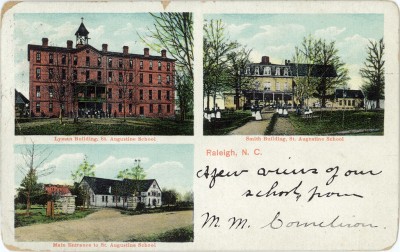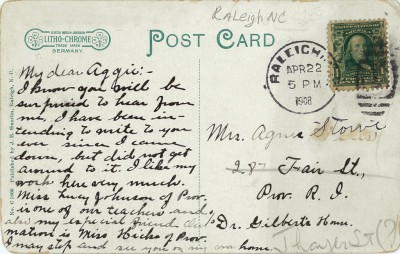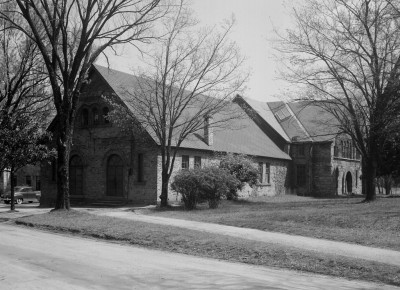St. Augustine School (Main Entrance, Lyman Building, Smith Building), Raleigh, N.C.
For Flashback Friday this week we feature an early ‘multi-view’ postcard depicting scenes on the St. Augustine’s College campus. Only one of the buildings seen here is still standing today.
A few views of our school, from M.M. Cornelison
My Dear Aggie:
I know you will be surprised to hear from me. I have been intending to write to you ever since I came down, but did not get around to it. I like my work here very much. Miss Lucy Johnson of Prov. is one of our teachers and also my especial friend. Our matron is Miss Hicks of Prov. I may stop and see you on my way home
Raleigh has been the home of two African-American institutions of higher learning since the 1860s — Shaw University (1865) and St. Augustine’s (1867). We have previously published two postcards depicting Shaw, but this is our first of St. Aug’s.
Fulfilling a Dream — St. Augustine’s University
With the assistance of the Episcopal Diocese of North Carolina, St. Augustine Normal School and Collegiate Institute was founded in Raleigh in 1867. Its mission was to educate freedmen as teachers, domestics, and tradesmen. In the ensuing decades, its scope expanded, and the name of the school was changed to St. Augustine’s School in 1893. With the addition of a nursing school and a liberal arts curriculum, it became St. Augustine Junior College in 1919. The school’s status was upgraded to a four-year institute in 1927, and the name was subsequently changed in 1928 to St. Augustine’s College. Finally, in 2012, the college became St. Augustine’s University.
Over the years many collegiate buildings were erected on St. Augustine’s campus. Although most of the early structures have been long lost through fire or demolition, a small core of early buildings remains near the main campus entrance. These are St. Augustine’s Chapel (1895), Benson Library/Taylor Hall (1898 and 1902), and the now sadly ruinous St. Agnes Hospital. Together they comprise the St. Augustine’s Collegiate Historic District, which is listed on the National Register of Historic Places.
Below are archival photos (1949) of two of the college buildings depicted on this week’s postcard.
The first Benson Library building is seen on the right of the frame, and the Taylor Hall auditorium is on the left.
Benson Library/Taylor Hall is actually the combination of two buildings erected five years apart. Benson library was constructed in 1898 of locally quarried stone in the Romanesque style by St. Augustine students themselves (some sources cite 1896). Taylor Hall, built as the campus auditorium, followed in 1902. After a new Benson Library was erected in the 1920s, the Benson/Taylor complex was renamed simply Taylor Hall.
The Lyman Building presided regally over St. Augustine’s central campus for more than 75 years.
The Lyman Building was an imposing 4-story brick structure, erected probably about 1880. It was named in honor of North Carolina Bishop Theodore Lyman, and served as a men’s dormitory and classroom building. It was demolished in the 1960s.
Smith Building, as depicted on our postcard, was one of the earliest to be erected on the St. Augustine campus, probably about 1870. The frame, 3-story, mansard-roofed women’s dormitory once stood on the site of the present-day lawn in front of Delany and Penick Halls. It was demolished sometime in the 1920s.
Although a small private school, St. Augustine’s University is today a thriving collegiate environment comprising 47 buildings on a 122-acre campus with an enrollment of more than 1,500 students.
I just wish the university administration would get busy on the restoration of the well-known campus landmark that is historic Saint Agnes Hospital!
Our Flashback Friday postcard this week was published by James E. Hamlin, the African-American proprietor of the People’s Drug Store, located for many years on E. Hargett St. It was distributed by American News Agency of New York.
American News Co. Â 1864-1957
119 Nassau Street, New York, NYFounded in 1864, this firm became a major distributor of books, magazines, newspapers, and postcards. Nearly all of their output was in view-cards. Most of their cards were printed in Leipzig, Dresden and Berlin, Germany. Their closure in 1957 led to great difficulties in distribution, putting many small publishers out of business as well.
Their first series has a letter A prefix followed by a string of sequential numbers. When these numbers ran out they began their B series with numbers running 1- 12200. The C series ran up to 15000. Eventually cards were just numbered sequentially without regard to style. Many cards with undivided backs were reprinted with divided backs after 1907.
Litho-Chrome
Litho-Chrome is a trade name for a type of German made postcard distributed by the American News Company. Their individual colors are sharp and tend to stand out. Ink coverage is sometimes so heavy that it renders scenes highly unnatural.
“Flashback Friday†is a weekly feature of Goodnight, Raleigh! in which we showcase vintage postcards depicting our historic capital city. We hope you enjoy this week end treat!
Â





 Sign up for the Newsletter
Sign up for the Newsletter
10/17/2014
My great aunt, Agnes Elmendorf taught at this school for at least 10 years. I found her on the 1910 census as well as the 1920 census. Her father was John James Elmendorf, an Episcopal minister who taught theology and philosophy in Wisconsin and Illinois. I’d love to see a picture of her if you could guide me to where I might possibly find one. I’ve asked the school through Facebook, but have not received an answer.
Thank you, Emilie Everett
10/17/2014
Emilie Everett — I suggest you contact St Aug’s university archives directly. They will probably have information about your great aunt, and possibly even a photograph! Good luck in your search! Here is the link — http://library.st-aug.edu/collections/university-archives.html
10/17/2014
Thank you so very much, Raleigh Boy. As soon as Friday Night football is over I’ll use the link. (Can’t help being a Texan, we love our football!) :)